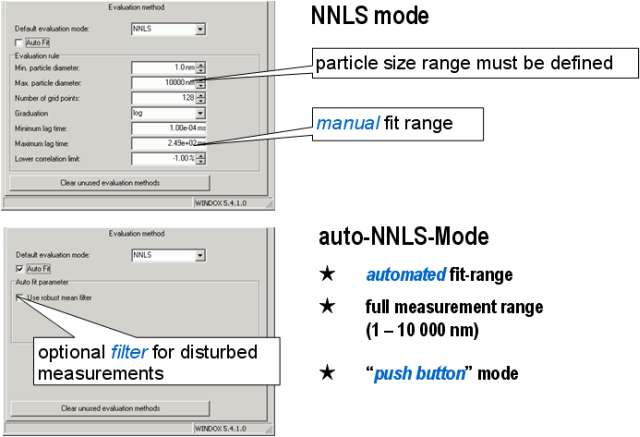Sympatec GmbH has released a major re-design of its unique Dynamic Light Scattering based NANOPHOX PCCS instrument.
The Sympatec specific NNLS evaluation algorithm, allowing for secure determination of size distributions even with multimodal structures has now been enhanced with the auto-NNLS mode. The outstanding performance provides very reliable and realistic information about the particle size distributions, which are at the same time highly reproducible. The auto-NNLS mode requires no operator input for optimum determination of evaluation parameters and thus is applicable in validated environments and for FDA conform SOPs as well. However, for special tasks manual operation and optimisation if requested is still available.

View on the WINDOX 5 definition pages for the NNLS and auto-NNLS mode
showing that no user input is required for the auto-NNLS mode.
Precise recording and evaluation of the progression of the cross correlation function during the measurement and the application of robust statistics result in reliable particle size distributions. The new quality of results is a consequence of the direct calculation of the Q3 distribution and hence no need for primary calculation of an intensity distribution (Qint- distribution) as is common for the 2nd Cumulant PCS method and the secondary conversion into a Q3 distribution, which inevitably leads to unrealistic Q3 results and cannot be compared to other methods such as TEM and Ultracentrifuge.
auto-NNLS is the missing link to availability of an operator independent push-button-instrument maintaining the ambition to use appropriate raw signals only and evaluate according to scientifically sound and correct methods without any assumptions regarding the final results.
auto-NNLS also features an optional filter that can be applied whenever the measurement is disturbed by extraordinary peaks. The filter does only affect the data evaluation and not the measured and data-base stored raw data. Thus the filter can be applied even after a measurement has been made and evaluated and results from different evaluation modes can be compared and be subject to further investigations, e.g. to other particle size measurement methods.
